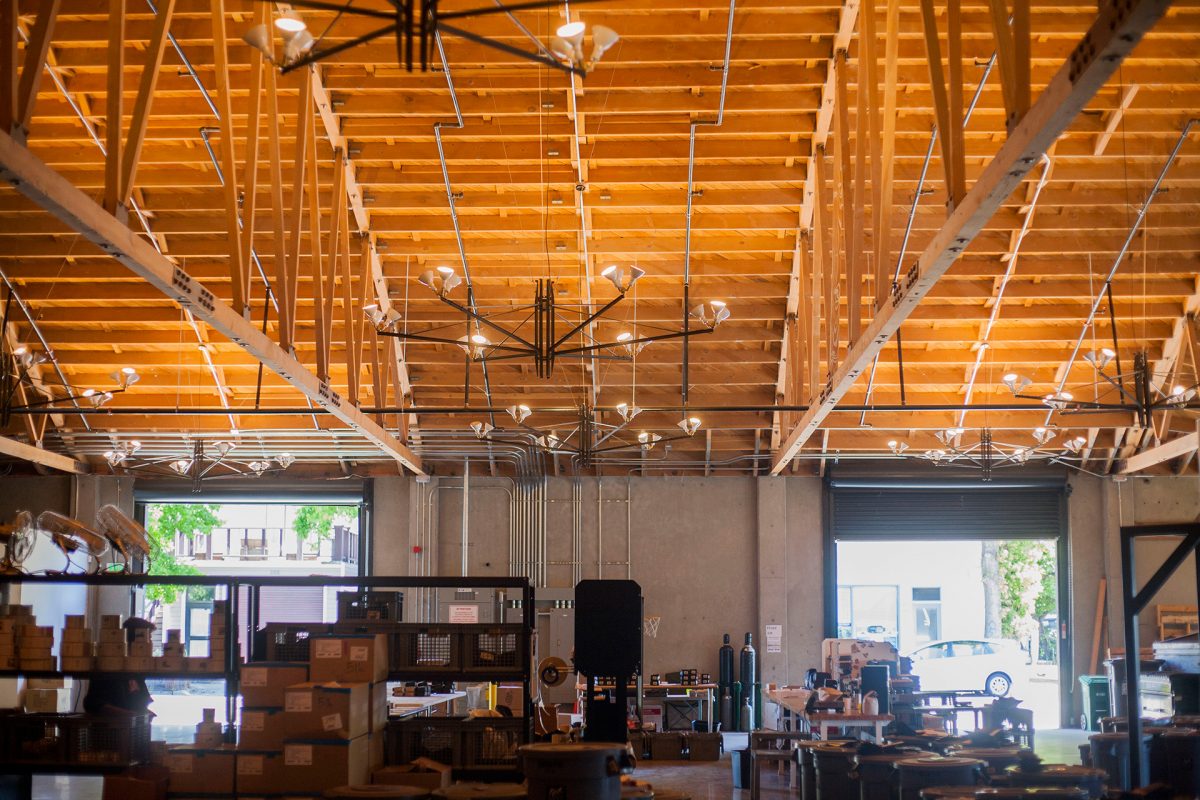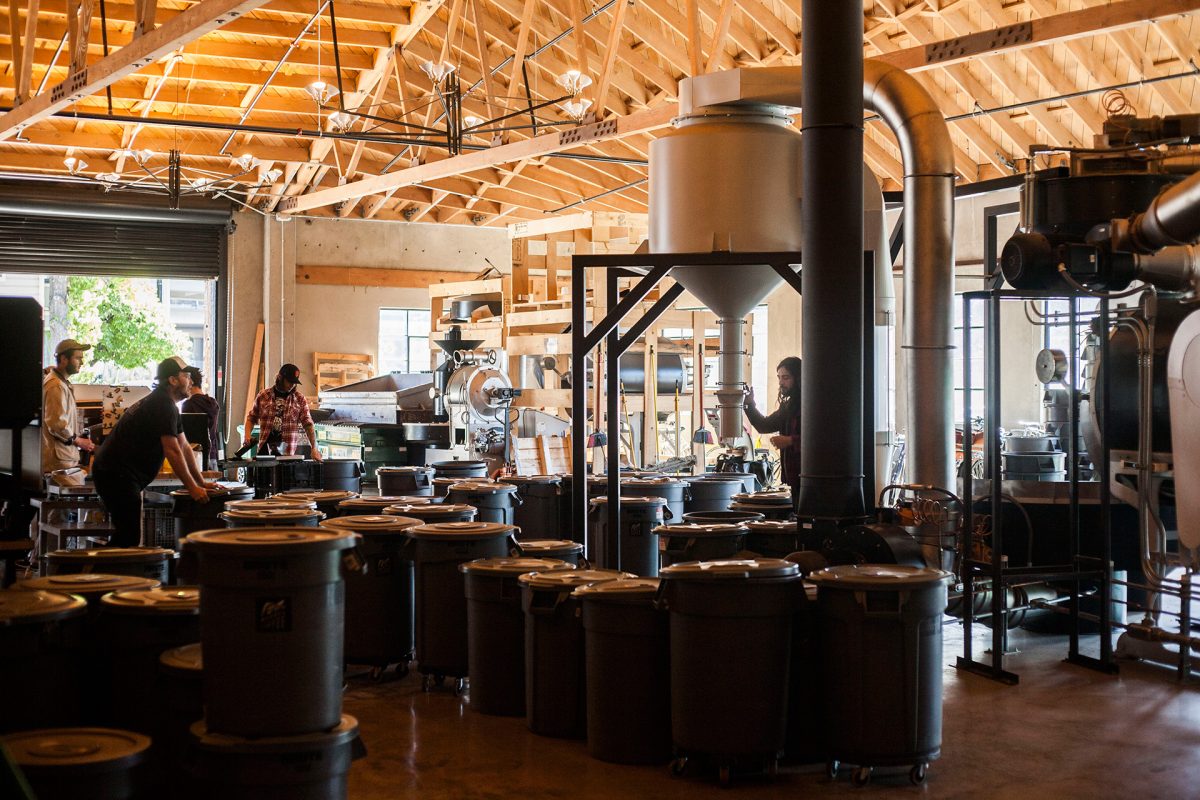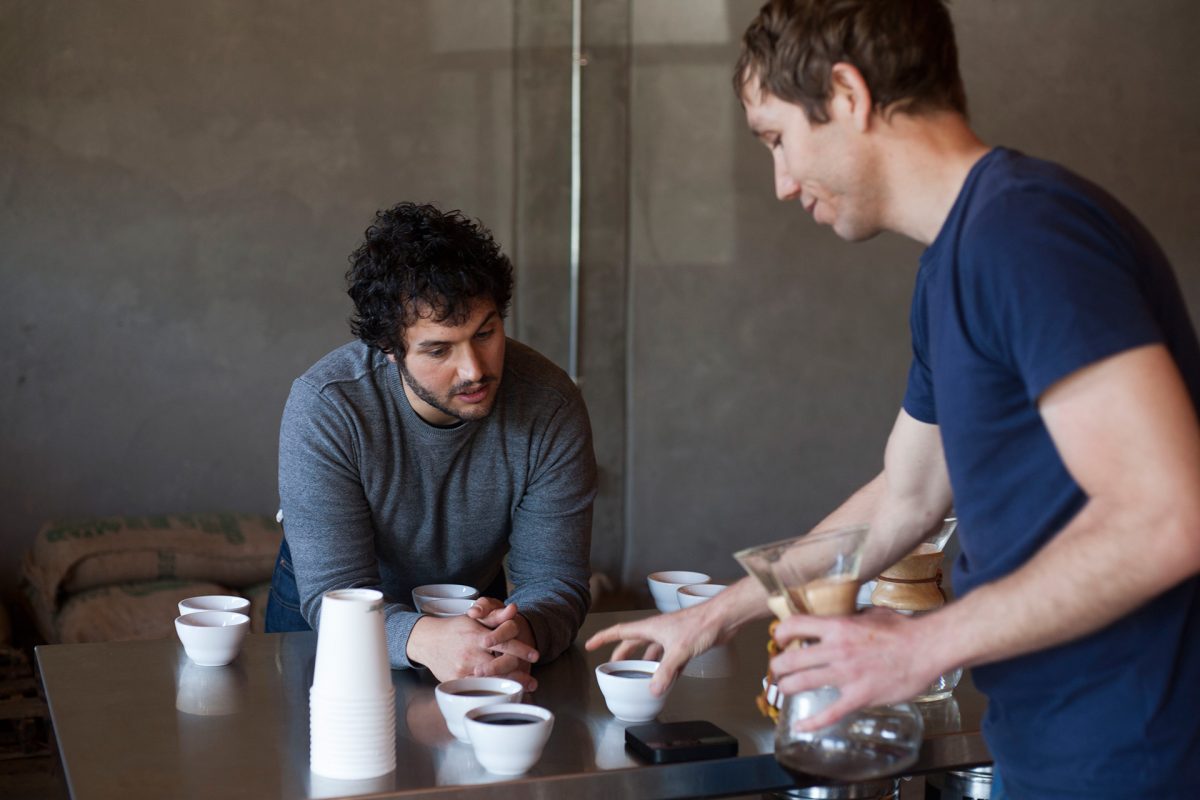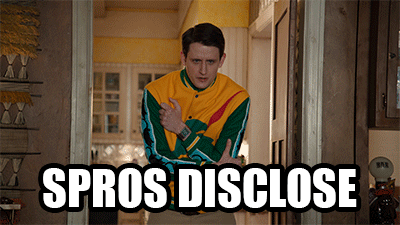
On a recent warm morning in West Oakland, I walked into a sunlit warehouse by the freeway and was presented with what I believe to be the future of cold coffee.
The space—Four Barrel‘s new roasting warehouse—is, like all of their shops, beautiful. Artsy lights dangle from the ceiling, casting a warm glow over the enormous German roaster and the crew getting business done. The exposed ceiling, leftover from the nightclub that once occupied the warehouse, is sandblasted down to its original wood. It looks, remarkably, like the ceiling of Four Barrel’s original space across the Bay, on 14th and Valencia in the Mission District.

Four Barrel sees the space as a launchpad for not only its next retail iteration, but for a new take on how the world enjoys cold coffee. The company hopes, with the help of new technology, to offer a cold coffee product quite different from what’s currently on the marketplace.
Eight years ago, when the revered San Francisco roaster threw open the doors on its gorgeous, and now iconic, shop on Valencia, its contemporaries were Ritual, Blue Bottle, and soon Sightglass—big names in specialty coffee that have each gotten bigger. The Bay Area’s coffee scene has had a breakneck pace in the years since, and Four Barrel has done the hard work of keeping up with it. The indie roaster’s beans are served in some 400 coffee shops nationwide. Their bread and coffee spot The Mill is one of San Francisco’s most popular coffee shops; they’ve opened a second Four Barrel location just off San Bruno, in Portola; and their original location still draws a line of epic proportions on most days. Still, amongst those who care to prognosticate the future of speciality coffee shops, Four Barrel’s has always been a mysterious one. The moves they’ve made—like the purchase of De La Paz a few years back—come slowly, making respectable ripples in the Bay before being subsumed by whatever coffee-related story pops up next. What their followers really wanted to know was: when was Four Barrel going to make its power play?

Expansion, as normal as it seems in San Francisco’s money-bleeding clime, is a scary thing—and doubly so for an independent small business like Four Barrel, which is owned jointly by Tal Mor, Jeremy Tooker, and Jodi Geren. “I remember Jodi saying, ‘when we hit 10,000 pounds a week,’ and Jeremy responding, ‘14,000 pounds,'” says Mor. “To do that, we had to reach this point where we were busting at the seams. The small to the big, that’s the scary moment,” Mor tells me. “You can fail.”
With tech money exploding the market, a big enough space to house the production area they dreamed of was nearly impossible. “We kept getting outbid by these crazy people, time and time again,” Mor says, speaking of the three years they searched for a proper space in San Francisco proper. “Finally it was like, let’s go to Oakland.”
The owners, along with a selection of staff and friends, built out the Oakland space almost entirely with their own hands, and their own money. For six months, the trio worked through every challenge on their own—sprinklers, floors, flying to Germany to help design a control panel for their roasters. The build-out of the warehouse became everything. And in challenging themselves through the creation of this new, giant baby, another realization crept up.
The owners of Four Barrel were getting bored.

“Doing the work to find incredible coffee and roasting that coffee well is still exciting,” Mor assures me, “but that excitement about learning you can make coffee taste like [this or that]—I hadn’t experienced that for a long time.” That is to say, until they started tinkering with cold coffee.
Let’s be frank: there is a schism growing in the coffee world. Some people love cold brew—the flavor spectrum it offers, the convenience and scalability it represents, and the coffee cultural boom time it is wrapped up with. But others feel that most cold brew coffee, as popular as it may be, isn’t all that good. A casual coffee drinker or average Sprudge reader might be surprised by this schism, but for coffee professionals (or professional coffee watchers), this topic is the stuff of piping hot debates across the coffee Twitter and Instasphere, and nowhere hotter than here in San Francisco, the home of Twitter and Instagram.
Yes, the icy brew so many shops—small, big, and huge—serve on hot days as an alternative to the hot, nuanced beverage we associate with coffee drinking, isn’t always the subtle, layered beverage you’ve been sold on. As ground coffee steeped in water for a long period of time, cold brew uses time instead of heat to extract a coffee’s basic flavors. In this expression, the resulting product can lack a distinguishing flavor, or so say the anti-CB partisans. It may taste old; it may even taste like the beans’ last stop after aging past optimal freshness and being relegated to the cold brew vat.
In the industry they call the non-flavor flavors of cold brew “tasting the process” and if you’ve had the majority of cold brew currently being served in America—especially right now, as we enter a time of peak cold brew—you, my friend, have tasted that process. But Mor, Tooker, and Geren thought: wouldn’t it be nicer if you just tasted the coffee?

“Cold brew wasn’t something we wanted to drink,” Mor admits. He says the team wanted to try and make cold-kegged coffee “that we felt confident in, that upheld our green buying and our roasting.” It was Brett Whitman, Four Barrel’s Head Trainer, who gave the idea the push it needed. “Brett asked, ‘What do you need?'” Mor says, “And we said, ‘someone to build the [cold] coffee program that we want.'” Whitman, a Sound Engineering major in college and a tinkerer by nature, was that someone.
For the last six months, Whitman has worked almost solely on creating a new process for chilling coffee so it can be placed into kegs and shipped to wholesalers. “Right away, we knew that we had to throw cold brew off the table,” Whitman says, “With cold brew you couldn’t tell origin, you couldn’t sense acidity structures—you always tasted the process.”
The difficulty in making cold, keggable coffee, Whitman says, is the cooling-down process. To make fresh, hot-brewed coffee into cold coffee, you have to lower the temperature of hot coffee from 200 degrees down to a “cold” 40 degrees within a 10-second window, without allowing variables like oxygen contact to affect the flavor of the brew. To do so, Whitman reached into the world of beer and liquor brewing, a field that had found success in lowering temperatures quickly and efficiently. “At every turn,” Whitman says, “from pumps to everything else, we found passionate, craft-oriented, family-owned businesses who wanted to help with the build-outs, to solve the problems, to engage with us.”

Though the actual process and technology behind Four Barrel’s new cold coffee is a proprietary secret, Whitman offers a general explanation: “We are transferring heat from the mass of hot coffee to a mass of very cold liquid. The efficiency [with which] we can move the heat is what allows us to cool it so quickly. And if you can cool it down fast enough, which we can, you also activate these volatile aromatics,” he says. “It’s a much more refined and enlightened way of doing it.” In the simplest terms, Four Barrel has developed a method to cool coffee very, very quickly without unfortunate variables that affect the taste. As dumb as it sounds, they’ve created a method of reliably making hot coffee—and all of its many flavors—cold.
In the samples I tasted, Four Barrel’s characteristic light-roasted, bright and citric coffees shone through just as they did in their hot iterations, capturing their essence as intended. I tasted several different batches of both Kenyan and Ethiopian cold coffees, straight from the keg, and each one of them, though subtly different, expressed the sort of lively, round, fruity taste these points of origin have traditionally been associated with.
This product won’t be for everyone. For every person who wants a subtle wash of flavor with their coffee, there’s another who wants the nostalgic, burnt ochre of darkly roasted beans, ready to be drowned in milk or its alternatives. But after years of drinking cold brew and not loving it, tasting cold coffee that maintained the flavor characteristics of its original form felt like a revelation.
What’s more, it’s not just the flavor of this coffee that heralds a step forward into the cold coffee future. It’s the ability to keg, and therefore preserve, those flavors, creating a sort of varietal system for cold coffee. Wine and coffee are oftentimes placed in a similar sandbox, but with Four Barrel’s new system, the gap between the two grows infinitely smaller. “Using this process,” Whitman says, “means we can bottle this and shelve it indefinitely, with the aromatics intact.”

So perhaps one day years into the future, coffee aficionados will be able to open the door to their dimly lit cellar on a warm summer morning, strut on down, and grab a bottle of Four Barrel Peru from 2017 that, when opened, will taste the way Four Barrel intended it to when it was originally bottled. What’s even crazier, the process theoretically allows for the coffee to be heated up again without the flavors changing drastically. Four Barrel has, in effect, created a way to maintain the flavor profiles of specific vintages of coffee into the indefinite future.
In the definite future, however, Four Barrel has plans to open a new shop in San Francisco’s Inner Sunset neighborhood. Beyond that, rumors are swirling about a Four Barrel expansion into another major North American market later this year. In the Bay Area, kegs of cold coffee began arriving at Four Barrel’s cafes in mid-June. Bottled versions are destined for the shelves of select grocers. The shift is perceptible. It feels as if after years of pleasantly keeping pace, Four Barrel has finally pushed the needle of coffee in a big, discernible way. Their way.
Noah Sanders (@sandersnoah) is a Sprudge.com staff writer based in San Francisco, and a contributor to SF Weekly, Side One Track One, and The Bold Italic. Read more Noah Sanders on Sprudge.

Four Barrel is an advertising partner on the Sprudge Media Network.
The post Four Barrel Fights For The Future Of Cold Coffee appeared first on Sprudge.

